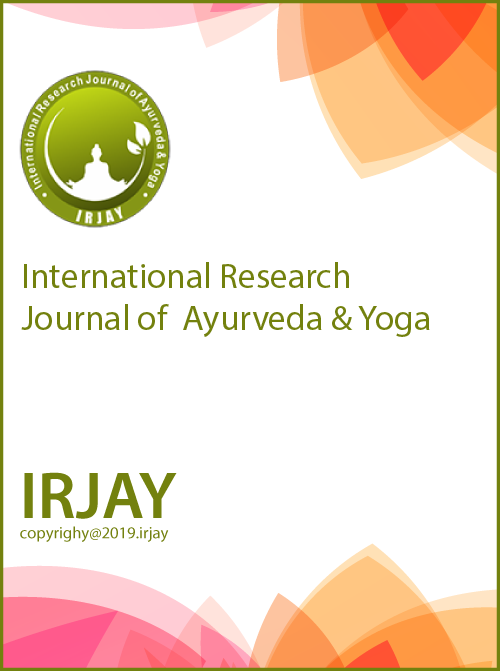Literary Review on Apana Vayu W.S.R. to Micturition
Keywords:
Apana vayu, Ayurveda, Micturition, Saman Vayu, Tri-DoshaAbstract
The primary goal of Ayurveda is to understand the fundamental principles of the Indian system of medicine and apply them for effective disease management. Ayurveda offers various concepts that explain and maintain individual health. Among these, the concepts of Dosha, Dhatu, and Mala are regarded as the foundational pillars of Ayurveda. The core theory underlying these principles is the Tri-Dosha Siddhanta, which states that Vata, Pitta, and Kapha are responsible for maintaining the body’s physiological functions. Vata Dosha governs all movement-related activities within the body and is further categorized into five subtypes, one of which is Apana Vayu. Apana Vayu is formed during the final stage of digestion, known as Katu Paka. Along with Samana Vayu, it aids in the breakdown of digested food and the formation of Kitta (excreted waste). Apana Vayu plays a crucial role in the excretory process by regulating the elimination of urine and feces. Notably, the action of voiding urine and feces is primarily governed by Apana Vayu, except in infants. This article aims to elaborate on the literature related to Apana Vayu in the context of the urinary mechanism. Micturition is a physiological process through which urine is expelled from the urinary bladder, controlled by a reflex mechanism that facilitates voluntary control over urination. To explore this correlation, studied classical Ayurvedic texts alongside modern physiological concepts to provide a detailed analysis of Apana Vayu’s role in micturition. This article is a humble attempt to highlight the relationship between Apana Vayu and micturition, exploring whether a direct resemblance exists between the two concepts.
Downloads
References
1. Charaka S. In: Acharya YT, editor. Charaka samhita. Varanasi: Chaukhambha Surbharati Prakashan; 2014.
2. Sushruta S. In: Acharya YT, editor. Sushruta samhita. Varanasi: Chaukhambha Sanskrit Sansthan; 2016.
3. Vagbhata A. In: Murthy KR, Translator. Ashtanga hridaya. Varanasi: Chaukhambha Krishnadas Academy; 2017.
4. Vagbhata A. In: Murthy KR, Translator. Ashtanga samgraha. Varanasi: Chaukhambha Orientalia; 2015.
5. Sharma PV. Dravyaguna vijnana. Vol. 2. Varanasi: Chaukhambha Bharati Academy; 2012.
6. Tripathi B. Madhava nidana, with madhukosha commentary. Varanasi: Chaukhambha Sanskrit Sansthan; 2015.
7. Srikantha Murthy KR. Sarangadhara samhita. Varanasi: Chaukhambha Orientalia; 2013.
8. Pandit K. In: Mishra LN, editor. Bhavprakasha nighantu. Varanasi: Chaukhambha Bharati Academy; 2011.
9. Sharma RK, Dash B. Charaka samhita: Text with English translation and commentary. Vol. 1. Varanasi: Chaukhambha Sanskrit Series Office; 2014.
10. Mishra SS. Ayurveda ka vaigyanik adhar. Varanasi: Chaukhambha Sanskrit Bhavan; 2010.
11. Bhattacharya N. Concepts of vata in ayurveda. Kolkata: University of Calcutta; 2005.
12. Guyton AC, Hall JE. Textbook of medical physiology. 13th ed. Philadelphia, PA: Elsevier; 2015.
13. Tortora GJ, Derrickson BH. Principles of anatomy and physiology. 15th ed. New York: Wiley; 2017.
14. Boron WF, Boulpaep EL. Medical physiology: A cellular and molecular approach. 3rd ed. Philadelphia, PA: Elsevier; 2016. 15. Rhoades RA, Tanner GA. Medical physiology. 2nd ed. Baltimore: Lippincott Williams and Wilkins; 2003.
16. Hall JE. Guyton and hall textbook of physiology. 14th ed. Philadelphia, PA: Elsevier; 2020.
17. Ganong WF. Review of medical physiology. 26th ed. New York: McGraw-Hill; 2019.
18. Hall JE, Guyton AC. Guyton and hall textbook of medical physiology. 14th ed. Netherlands: Elsevier;2010.
19. Barrett KE, Barman SM, Boitano S, Brooks HL. Ganong’s review of medical physiology. 25th ed. New York: McGraw-Hill; 2016. 20. Kumar P, Clark M. Kumar and Clark’s clinical medicine. 10th ed. London: Elsevier; 2020.
21. Dutta DC. Textbook of obstetrics. 8th ed. New Delhi: Jaypee Brothers; 2019.
22. Moore KL, Persaud TV, Torchia MG. Before we are born: Essentials of embryology and birth defects. 10th ed. Philadelphia, PA: Elsevier; 2019.
23. Rosen R, Kapur J, Fisher RS. Neurology of micturition: A clinical and experimental approach. Cambridge: Cambridge University Press; 2014.
24. Khandelwal KR. Practical pharmacognosy: Techniques and experiments. 20th ed. Pune: Nirali Prakashan; 2019.
25. Tiwari PV. Ayurveda ka vaigyanik adhar. New Delhi: National Institute of Ayurveda; 2010.
26. Jansen RP. The physiology of micturition and bladder control. New York: Oxford University Press; 2015.
27. Maggi CA. The autonomic nervous system: Control of micturition. 2nd ed. London: Springer; 2017.
28. Pandya SK. Neurophysiology of micturition and its disorders. Mumbai: Tata McGraw-Hill; 2014.
29. Nitti VW. The urinary bladder: Physiology, pathophysiology, and pharmacology. London: Springer; 2018.
30. Shukla V, Tripathi RD. Charaka samhita (with charaka chandrika Hindi commentary). Varanasi: Chaukhambha Sanskrit Pratishthan; 2013. 31. Marieb EN, Hoehn K. Human anatomy and physiology. 11th ed. Boston: Pearson Education; 2019.
32. Rai L. Urological disorders in ayurveda. Delhi: Chaukhambha Orientalia; 2016.
33. Kumar S, Paul S. Ayurvedic concepts of Mutraghata (urinary retention) and its management. J Ayurveda Integr Med. 2017;8(3):145-9. 34. Sharma AK. Physiology of excretion: An ayurvedic perspective. Indian J Tradit Knowl. 2018;17(4):678-82.
35. Mishra H. Mutrakricchra: Ayurvedic diagnosis and management. AYU J. 2016;37(2):84-91.
36. Sane RT. Principles of ayurvedic medicine: Vata, pitta, and kapha. Mumbai: Chaukhambha Sanskrit Bhavan; 2012.
37. Deshpande PJ. Ayurvedic treatment for urinary disorders. J Res Ayurveda. 2019;5(1):24-30.
38. Bhattacharya A. Correlation of apana vayu with urological disorders in ayurveda. I J Ayurvedic Res. 2020;6(2):55-61.


